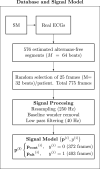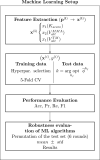Machine Learning approach for TWA detection relying on ensemble data design
- PMID: 36699267
- PMCID: PMC9868537
- DOI: 10.1016/j.heliyon.2023.e12947
Machine Learning approach for TWA detection relying on ensemble data design
Abstract
Background and objective: T-wave alternans (TWA) is a fluctuation of the ST-T complex of the surface electrocardiogram (ECG) on an every-other-beat basis. It has been shown to be clinically helpful for sudden cardiac death stratification, though the lack of a gold standard to benchmark detection methods limits its application and impairs the development of alternative techniques. In this work, a novel approach based on machine learning for TWA detection is proposed. Additionally, a complete experimental setup is presented for TWA detection methods benchmarking.
Methods: The proposed experimental setup is based on the use of open-source databases to enable experiment replication and the use of real ECG signals with added TWA episodes. Also, intra-patient overfitting and class imbalance have been carefully avoided. The Spectral Method (SM), the Modified Moving Average Method (MMA), and the Time Domain Method (TM) are used to obtain input features to the Machine Learning (ML) algorithms, namely, K Nearest Neighbor, Decision Trees, Random Forest, Support Vector Machine and Multi-Layer Perceptron.
Results: There were not found large differences in the performance of the different ML algorithms. Decision Trees showed the best overall performance (accuracy , precision , Recall , F1 score ). Compared to the SM (accuracy 0.79, precision 0.93, Recall 0.64, F1 score 0.76) there was an improvement in every metric except for the precision.
Conclusions: In this work, a realistic database to test the presence of TWA using ML algorithms was assembled. The ML algorithms overall outperformed the SM used as a gold standard. Learning from data to identify alternans elicits a substantial detection growth at the expense of a small increment of the false alarm.
Keywords: Cross Validation (CV); Electrocardiogram (ECG); Machine Learning (ML); Modified Moving Average Method (MMA); Repolarization; Spectral Method (SM); Time Method (TM); T–Wave Alternans (TWA).
© 2023 The Author(s).
Conflict of interest statement
The authors declare no conflict of interest.
Figures






Similar articles
-
Machine learning based detection of T-wave alternans in real ambulatory conditions.Comput Methods Programs Biomed. 2024 Jun;249:108157. doi: 10.1016/j.cmpb.2024.108157. Epub 2024 Apr 3. Comput Methods Programs Biomed. 2024. PMID: 38582037
-
Benchmarking of a T-wave alternans detection method based on empirical mode decomposition.Comput Methods Programs Biomed. 2017 Jul;145:147-155. doi: 10.1016/j.cmpb.2017.04.005. Epub 2017 Apr 25. Comput Methods Programs Biomed. 2017. PMID: 28552120
-
Effect of noise on T-wave alternans measurement in ambulatory ECGs using modified moving average versus spectral method.Pacing Clin Electrophysiol. 2009 May;32(5):632-41. doi: 10.1111/j.1540-8159.2009.02337.x. Pacing Clin Electrophysiol. 2009. PMID: 19422585
-
Characterization of noise in long-term ECG monitoring with machine learning based on clinical criteria.Med Biol Eng Comput. 2023 Sep;61(9):2227-2240. doi: 10.1007/s11517-023-02802-5. Epub 2023 Apr 3. Med Biol Eng Comput. 2023. PMID: 37010711 Free PMC article. Review.
-
The clinical value of T-wave alternans derived from Holter monitoring.Europace. 2017 Apr 1;19(4):529-534. doi: 10.1093/europace/euw292. Europace. 2017. PMID: 28339589 Review.
References
-
- Smith J.M., Clancy E.A., Valeri C.R., Ruskin J.N., Cohen R.J. Electrical alternans and cardiac electrical instability. Circulation. 1988;77(1):110–121. - PubMed
-
- Rosenbaum D.S., Albrecht P., Smith J.M., Garan H., Ruskin J.N., Cohen R.J. Electrical alternans and vulnerability to ventricular arrhythmias. N. Engl. J. Med. 1994;330(4):235–241. - PubMed
-
- Gehi A.K., Stein R.H., Metz L.D., Gomes J.A. Microvolt T–wave alternans for the risk stratification of ventricular tachyarrithmic events. J. Am. Coll. Cardiol. 2005;46(1):75–82. - PubMed
LinkOut - more resources
Full Text Sources

